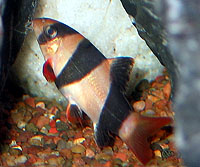Clown loach: Difference between revisions
mNo edit summary |
GrahamBould (talk | contribs) mNo edit summary |
||
| Line 37: | Line 37: | ||
* [http://www.loaches.com Loaches.com] Website that includes information, photos and videos of clown loaches |
* [http://www.loaches.com Loaches.com] Website that includes information, photos and videos of clown loaches |
||
[[Category: |
[[Category:Cobitidae]] |
||
[[de:Prachtschmerle]] |
[[de:Prachtschmerle]] |
||
Revision as of 18:02, 17 November 2006
| Clown loach | |
|---|---|

| |
| Scientific classification | |
| Kingdom: | |
| Phylum: | |
| Class: | |
| Order: | |
| Family: | |
| Genus: | |
| Species: | C. macracanthus
|
| Binomial name | |
| Chromobotia macracanthus | |
A clown loach or tiger botia, Chromobotia macracanthus, (formerly Botia macracanthus) is a freshwater fish belonging to the loach family (Cobitidae). Originating in Indonesia on the islands of Sumatra and Borneo, it is commonly kept as a pet in tropical aquaria. They have orange fins with 3 black bands on a yellowish body and some barbels about their mouth. They grow slowly to a maximum length of 11.8 in (30.0 cm). These fish do not readily breed in captivity, partly due to the fact that they do not reach sexual maturity until after nine or ten years of age. Clown loaches may live for up to 50 years.
A harmless, very active, social fish, they are best kept in groups of 5 or more. These fish have defensive spines located under their eyes. In cases of extreme distress they can deploy these spines. If a loach deploys its spines while caught in a net, untangling it is difficult. Some owners have been stabbed while trying to catch or touch these fish. When kept in groups smaller than 5, they may spend more time hiding under obstacles in the water. They are also found to make clicking noises when excited or eating. Sometimes they lie on their sides on the bottom of the tank and appear to be dead. This is a common event and the aquarist should be aware of this fact or unnecessary removal may occur. They natively live in a tropical climate and prefer water with a 5.0 - 8.0 pH, a water hardness of 5.0 - 12.0 dGH, and an ideal temperature range of 77 - 86 °F (25 - 30 °C). They eat small worms, crustaceans, and plant matter.
If you have noticed that your clown loaches do not come out of hiding, there are some easy things to adjust so that your clown loaches will be more comfortable. A good tank setup for a clown loach should include ample shade, plants (plastic or real), hiding places and other peaceful fishes. Make sure the environment is not too bright. Provide shade from tank lighting. The tank should not be next to a window.
Because clown loaches come from rivers and streams, they are accustomed to having other fishes and plants in their environment. Not having plants and/or other fishes can cause clown loaches to become stressed and to go into hiding. Before introducing clown loaches to your tank, make sure the fish you currently have are compatible because aggressive fish will stress your clown loaches and may need to be removed. Also, clown loaches are particularly susceptible to Ichthyophthirius (ich), so watch them closely when initially adding them to your tank and when you introduce new fish.
You should also provide a variety of foods for your loaches. Bottom Feeder Pellets should be given daily. You should feed your clown loaches live foods as well.
Clown loaches are also regarded as a natural way of controlling an infestation of small snails in the aquarium.
See also
References
- "Botia macracanthus". Integrated Taxonomic Information System. 11 November.
{{cite web}}: Check date values in:|date=and|year=/|date=mismatch (help) - Froese, Rainer, and Daniel Pauly, eds. (2004). Botia macracanthus in FishBase. September 2004 version.
External links
- Clown loach information site
- Loaches.com Website that includes information, photos and videos of clown loaches
